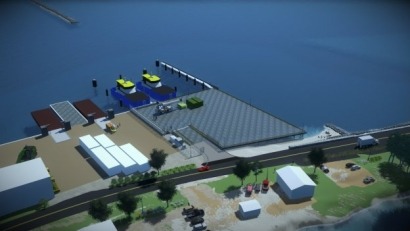
In addition to O&M technicians, the facilities will employ people with a range of skillsets, such as site managers, planners, helicopter pilots, crew transfer vessel (CTV) support staff, and health, safety and environmental (HSE) managers, among other positions.
“In many ways, Martha’s Vineyard is playing a starring role in this first in the nation project,” said Vineyard Wind CEO Klaus S. Moeller. “It’s not only where our company gets its name, it’s also going to be our long term home for O&M for 30 years, creating good paying year round jobs for islanders."
“The local workforce on Martha’s Vineyard will play a central role in the successful operation of this historic project, and AVANGRID is proud to commemorate the construction of these critical facilities at the Tisbury Marine Terminal,” said AVANGRID CEO Pedro Azagra.
Work at the Tisbury Marine Terminal began in late 2022, with dredging and other site preparation activities. When completed, the port facility will be able to support up to three CTVs that will be used to transport O&M technicians to the windfarm.
“On Martha’s Vineyard, Cape Cod, and Nantucket, our communities are witness to the effects of a rapidly changing climate every day,” said State Senator Julian Cyr. “The region’s viability and prosperity have always depended on our natural environment and ocean ecosystems, which are now at significant risk. We are at a critical moment. What we do today on the climate crisis will determine whether future generations can prosper or even survive."
“Massachusetts is leading our nation on clean energy, and Martha’s Vineyard is at the forefront of this revolution. This project will not only create thousands of local jobs, but will also help us reach our ambitious climate goals,” said State Representative Dylan Fernandes. “Vineyard Wind is a symbol of Massachusetts’ commitment to a clean energy future, and I’m thrilled to see the project come to fruition.”
Construction work is also active for the O&M service building which will be located on Beach Road in close proximity to the terminal. The facility will include offices, technician support space and storage. The building’s design incorporates sustainability initiatives such as solar panels, electric vehicle charging stations and bike parking.
“Through our landmark partnership with Vineyard Wind, culminating in the nation’s first offshore wind Community Benefit Agreement, we were able to secure several major benefits for our community which include: the revitalization of the Tisbury working waterfront that will enable dozens of skilled island based jobs, millions of dollars in funding to enhance our island’s resiliency at critical facilities through solar and battery storage projects, and direct financial support for income eligible residents to benefit from the transition to reduce and eventually eliminate fossil fuels”, said Vineyard Power President Richard J Andre. “I want to thank all the members of Vineyard Power, the Vineyard Wind team, the town of Tisbury, the Martha’s Vineyard Commission and MV Center for Education & Training for their contributions in making this day possible.”
A new hanger is also being constructed at the airport to house a helicopter that will service the project. Like the O&M service building, the hanger also includes sustainability initiatives, including an all-electric heating system.
Vineyard Wind has been actively working to fill positions with island residents, hosting multiple job fairs and weekly office hours.
Vineyard Wind recently submitted its first annual report to the state compiled by UMass Dartmouth and Springline Research Group that found Vineyard Wind more than doubled early estimates for the number of jobs created and dollars invested.
An 800-megawatt project located 15 miles off the coast of Martha’s Vineyard, Vineyard Wind will generate electricity for more than 400,000 homes and businesses in the Commonwealth of Massachusetts, create 3,600 Full Time Equivalent (FTE) job years, save customers $1.4 billion over the first 20 years of operation, and is expected to reduce carbon emissions by more than 1.6 million metric tons per year, the equivalent of taking 325,000 cars off the road annually.

